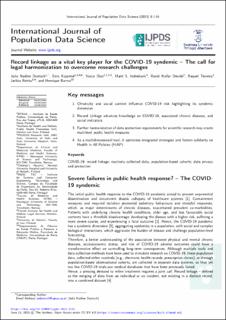| dc.description.abstract | The initial public health response to the COVID-19 pandemic aimed to prevent exponential dissemination and circumvent drastic collapses of healthcare systems [1]. Containment measures and required isolation promoted sedentary behaviours and stressful responses, which, as major determinants of chronic diseases, exacerbated prevalent co-morbidities. Patients with underlying chronic health conditions, older age, and less favourable social contexts have a threefold disadvantage: developing the disease with a higher risk, suffering a more severe course, and experiencing a fatal outcome [2]. Hence, the COVID-19 pandemic has a syndemic dimension [3], aggregating epidemics in a population, with social and complex biological interactions, which aggravate the burden of disease and challenge population-level forecasting.
Therefore, a better understanding of the association between physical and mental chronic diseases, socioeconomic status, and risk of COVID-19 adverse outcomes could have a transformative effect on controlling long-term consequences. Although multiple tools and data collection methods have been used to stimulate research on COVID-19, these population data, collected either routinely (e.g., electronic health records, prescription claims), or through population-based observational cohorts, are collected in separate data systems, so that yet too few COVID-19 trials use medical databases that have been previously linked.
Hence, a pressing demand to refine treatment requires a joint call: Record linkage – defined as the merging of data from an individual or an incident, not existing in a distinct record, into a combined dataset [4]. | en_US |

